BI303: Chapter 1
1/147
There's no tags or description
Looks like no tags are added yet.
Name | Mastery | Learn | Test | Matching | Spaced |
|---|
No study sessions yet.
148 Terms
How old is the Earth?
4.6 billion years old
Prokaryote
A unicellular organism that lacks a nucleus and membrane-bound organelles
- no nucleus
- no membrane-bound nucleus
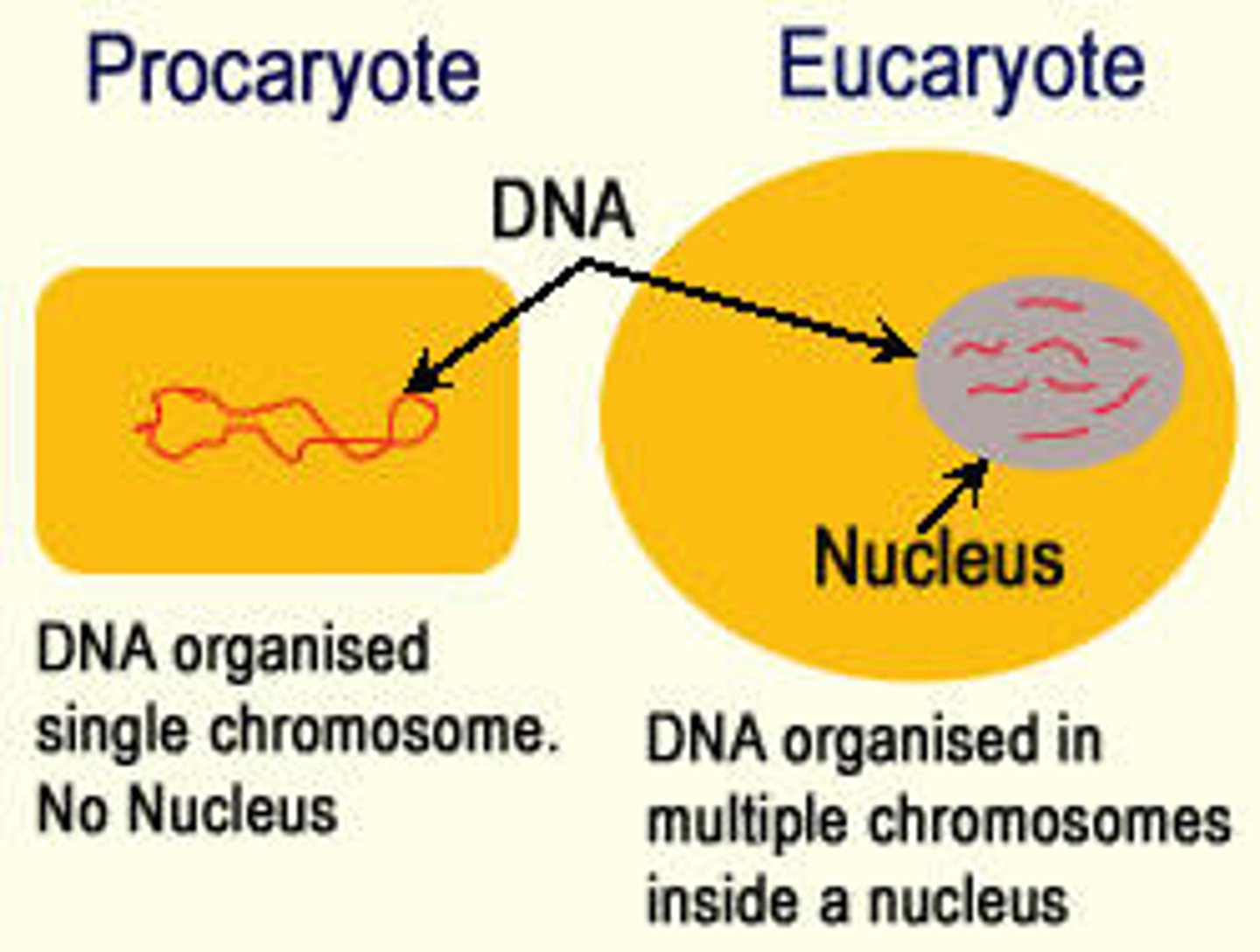
What are some examples of prokaryotes?
Bacteria and Archaea
Eukaryotes
organisms made up of one or more cells that have a nucleus and membrane-bound organelles
- nucleus
- membrane-bound organelles
Name parts of a cell that developed with eukaryotic development?
- nuclear membrane
- Peroxisome
- Lysosome
- ER
- name more!
What are examples of Eukaryotes?
plants, animals, fungi, protists
What is the oldest evidence of prokaryotic cells?
3.5 bya in Africa found in a pillow of lava that formed on the seabed
(3.6 - 3.8 bya trace fossils of prokaryotes)
When did eukaryotic cells originate and how?
Around 2 - 2.5 bya; prokaryotes took in mitochondria and became the first eukaryotic cell
(2.7 bya - fossils proposed to be Eukaryotes)
What is endosymbiosis
symbiosis in which one of the symbiotic organisms lives inside the other. (explains the origin of chloroplasts and mitochondria)
Metazoans
multicellular animals
Origin of Metazoans
875-650 mya; fossils found in Newfoundland (635-541 mya)
What are some theories of how life originated?
- Primordial Soup
- Hydrothermal vents
- Meteors and Comets
Primordial Soup
theory that the early oceans were a solution of organic molecules (that led to the development of living organisms)
Metazoans are
monophyletic
What are Metazoans numerous anamorphies?
- gastrulation and embryonic germ layer formation
- oogenesis and spermatogenesis
- unique sperm structure
- mitochondrial gene reduction
- epithelia with separate junctions
- tight junctions
- type IV collagen
- striate myofibrils
- actin and myosin
anamorphy
new trait or character that has evolved in a species or group
gastrulation
In animal development, a series of cell and tissue movements in which the blastula-stage embryo folds inward, producing a three-layered embryo, the gastrula. (major reorganization)
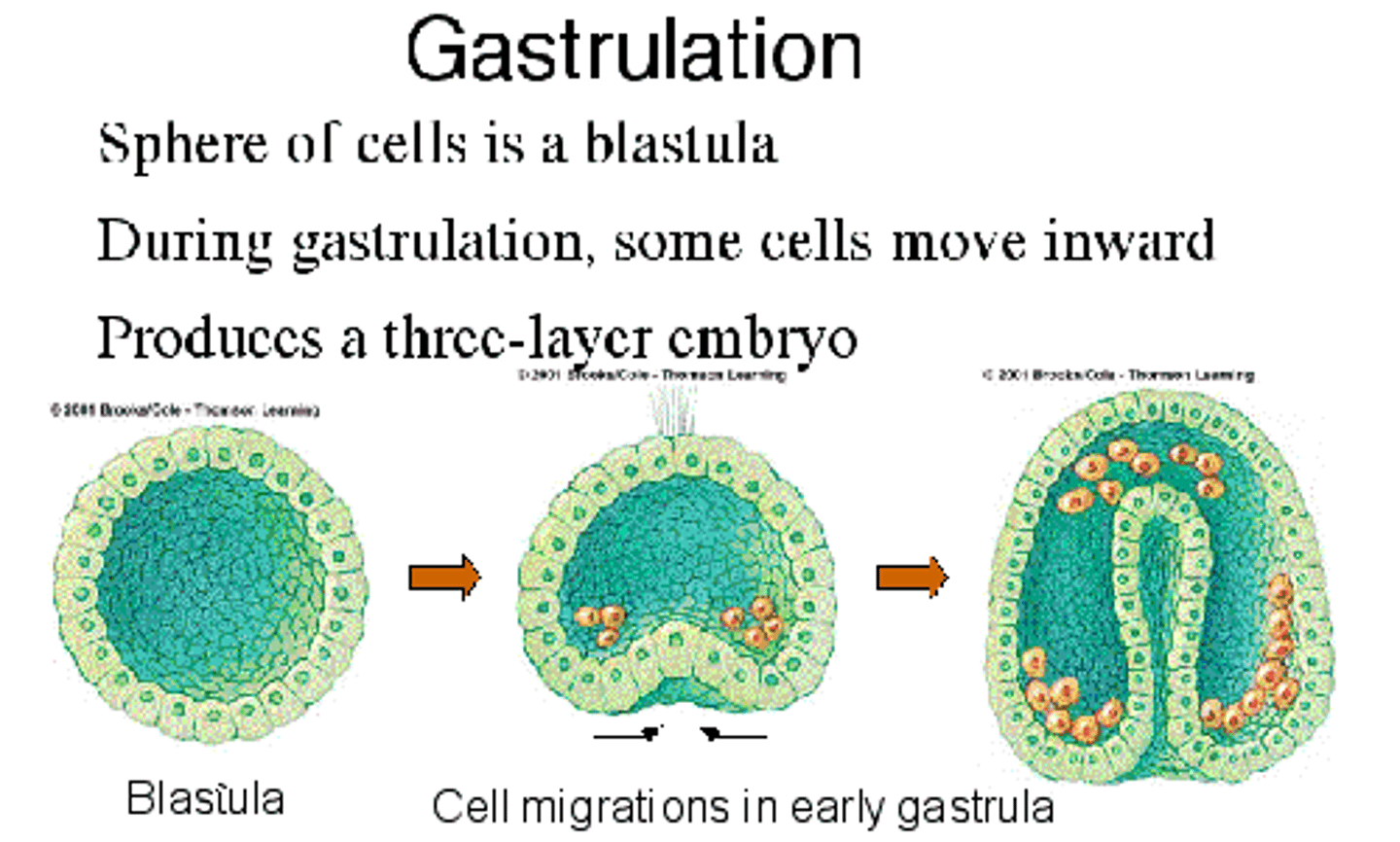
oogenesis
the production, growth, and maturation of an egg, or ovum
Spermatogenesis
the production of sperm cells
epithilia
-tightly packed cells that cover body surfaces and line internal organs and cavities
-often functions as a barrier (skin)
mitochondrial gene reduction
mitochondrial genes are transferred to the nucleus
Why are mitochondrial genes only passed down from the mother?
The mitochondria comes from the egg, not the sperm (sperm's mitochondria are usually degraded and not incorporated into the developing embryo)
Metazoa arose from
Opisthokonta
Opisthokonta
the eukaryotic supergroup that contains
- fungi
- metazoa
- protists
- some plants
Choanoflagellates
protists that are the closest living relatives of animals
What are the 3 great domains?
Bacteria, Archaea and Eukaryotes
Bacteria
- DNA dispersed throughout the cell
- no nuclei or membrane-bound organelles
- some use chlorophyll-based photosynthesis
Archaea
- DNA dispersed throughout the cell
- no nuclei or membrane-bound organelles
- cannot use chlorophyll-based photosynthesis
- contains extremophiles (living in extreme environments)
Chemoautotrophs
Organisms that use hydrogen sulfide or other chemicals as energy source instead of light.
Halophiles
"salt-loving" archaea that live in environments that have very high salt concentrations
Thermophiles
Archaea that thrive in very hot environments, such as volcanic springs.
Acidophiles
grow best in acidic habitats
Alkaliphiles
organisms that live above pH 8.5 (basic)
Barophiles
can survive under extreme pressure and will rupture if exposed to normal atmospheric pressure
How do Archaea differ from Bacteria and Eukaryota?
in the composition of their ribosomes, in the construction of their cell walls, and in the kinds of lipids in their cell membranes.
Eukaryotes
- DNA is in membrane-bound nucleus
Classification
The process of grouping things based on their similarities to sort evolutionary relationships
Name the different percentages of groups of species described
- Arthropoda: 82%
- Molluscs: 5%
- Pladyhelminthes (flatworms - 1%?)
Protists are
paraphyletic (not including all descendants of a common ancestor)
Monophyletic
ALL descendants came from one common ancestor
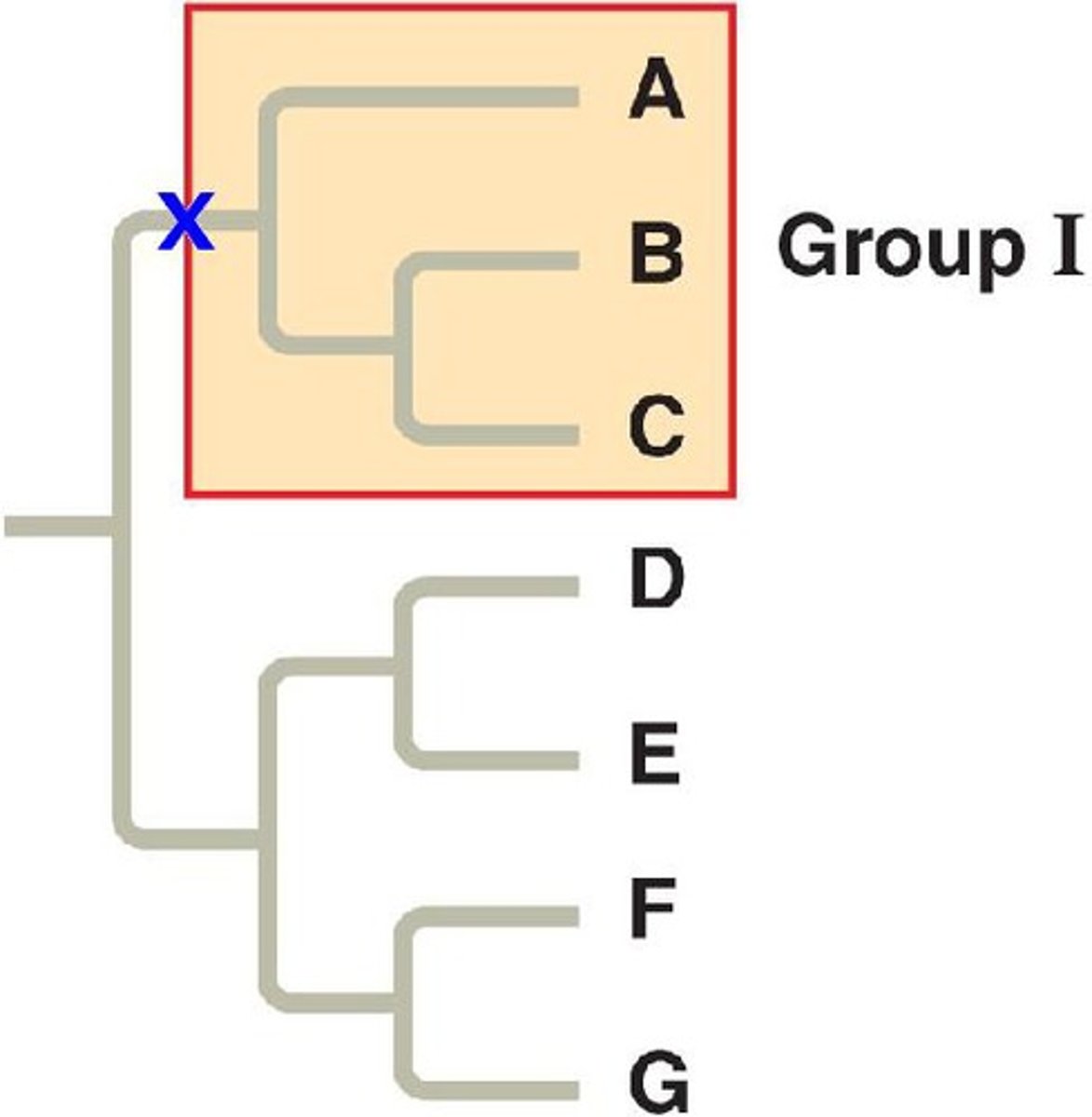
Name an example of monophyletic groups
Mammals, birds, tetrapods and amniotes (reptiles, birds and mammals)
Paraphyletic
pertaining to a grouping of species that consists of an ancestral species and some, but not all, of its descendants.
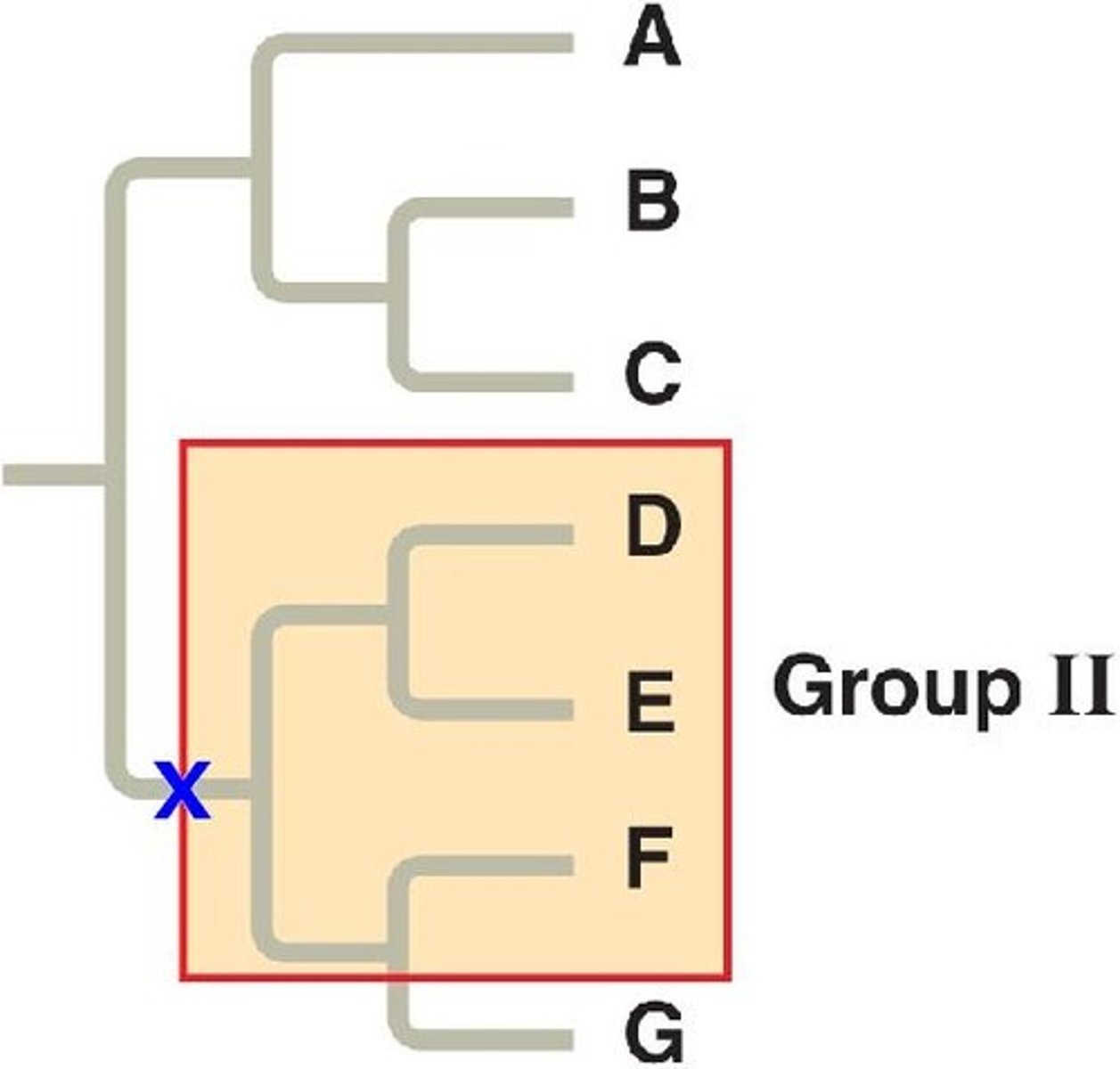
Name an example of a paraphyletic group
Crustaceans (bcs of hexapods - insects aren't included); invertebrates; reptiles
Name the different databases used for species
- US Geological Survey (USGS) and ITIS (species name and classification)
- Catalogue of Life (CoL)
- Encyclopedia of Life (EOL) project: species name AND ecological info
- WoRMs (World Register of Marine Species): goal of listing all described eukaryotic species, including their higher taxonomy.
When was the first trace of Eukaryotic life?
first benthic algae = 1.6 to 1.8 bya; first certain eukaryotic fossils of phytoplankton = 1.2 bya
Geological Time Scale
- Paleozoic
- Mesozoic
- Cenozoic
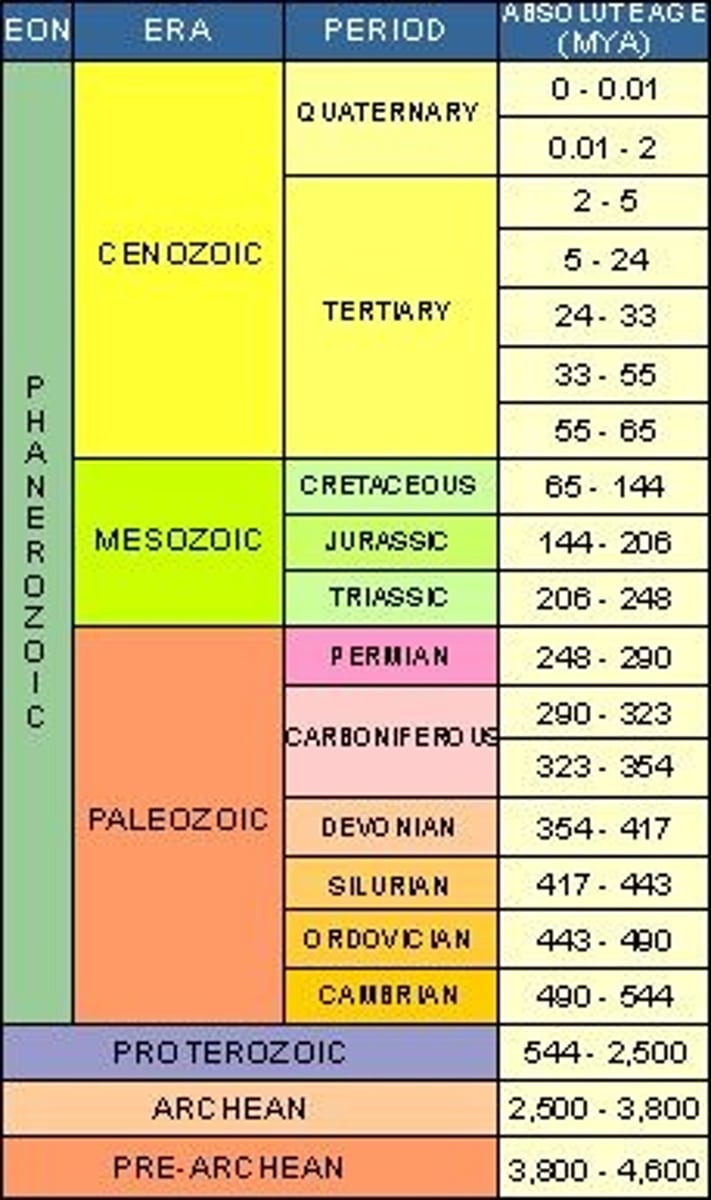
Precambrian (4.6 bya - 541 mya)
(Proterozoic Eon)
the oldest and longest span of geologic time; dominated by simple life forms like bacteria, algae and first multicellular organisms
- 3 "Snowball Earth" Events occurred at the end of the Proterozoic Eon
What were the Snowball Earth Events caused by?
- extreme glaciation, covering things in ice
- reduction in greenhouse gases (less volcanic emissions)
(escaped the ice age through rapid warming and volcanic activity)
These changes occurred during the breakup of supercontinent Rodinia,
the continent after Pangea
Ediacaran Period (part of Precambrian; 635-541 mya)
First large, complex multicellular life appears (soft-bodied organisms); marks the transition of the explosion of life in the Cambrian Period
*Extinction of many soft-bodied creatures due to increased Oxygen in waters (ocean chemistry, ecosystem shift, or early predation could have played a role)
What phyla were formed in the Ediacaran Period?
- Porifera
- Cnidaria
- Mollusca
- Annelida
and others (possibly Onychophora, Arthropoda, Echinodermata)
Paleozoic Era (541 mya - 251.9 mya)
Begins with the Cambrian Explosion; earliest invertebrates, fish and amphibians arise (explosion of bilateria, seed ferns, gymnosperms)
*Ends with the permian mass extinction
What phyla or characteristics arose in the Paleozoic Era?
- Large, calcareous body skeletons (archaeocyathans:coral like organisms that may have been early sponges)
- molluscs
- bryozoans
- brachiopods
- crustaceans
- chaetognaths
What fossil defines the base of the Cambrian?
Treptichnus pedum; first penetrative animal that burrows, suggesting good use of bioturbation
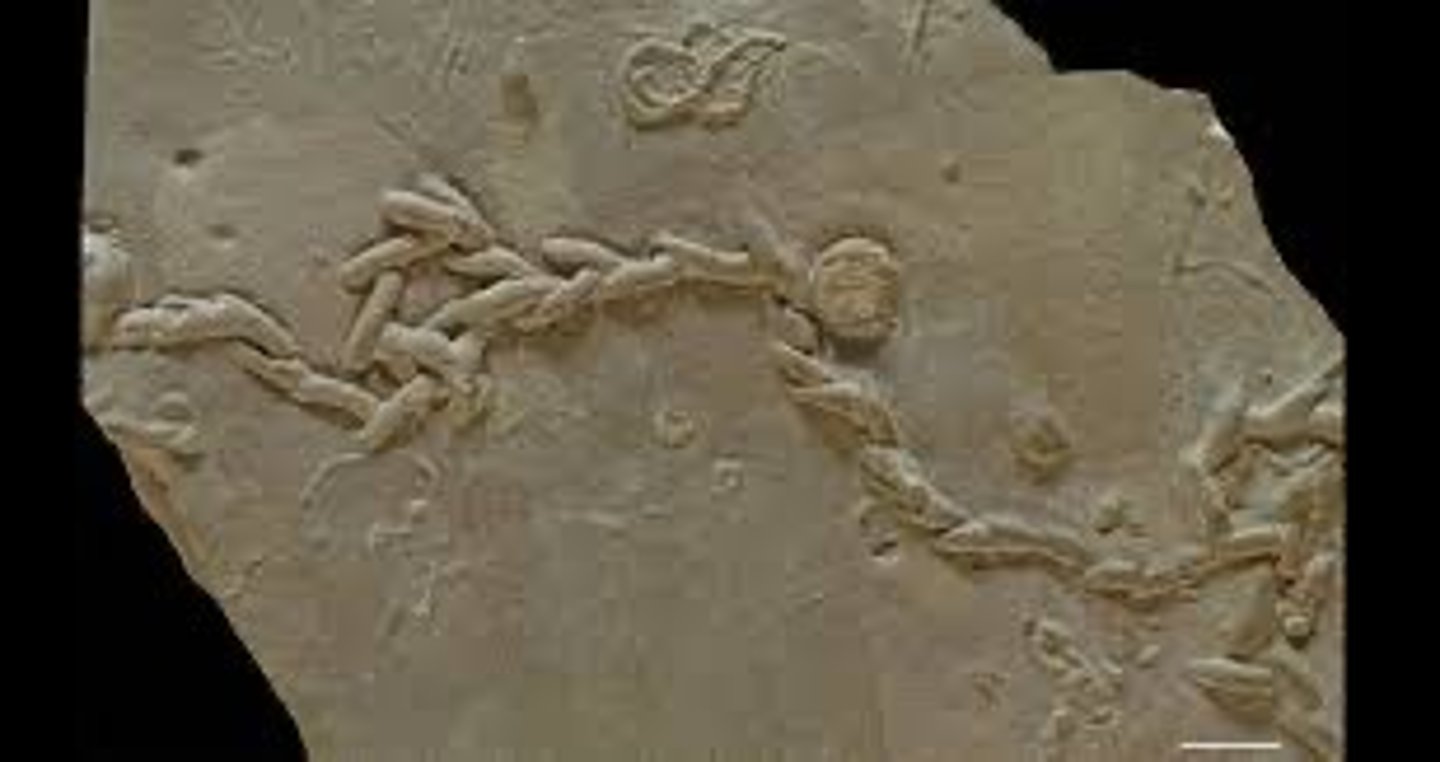
Mesozoic Era (252-66mya)
Divided into three periods: Triassic, Jurassic, Cretaceous
Triassic Period
Part of the Mesozoic Era, the period when dinosaurs first appeared. (248-213 million years ago)
- emergence of dinos
- warm climate
- Pangea
- vertebrate diversity
- end of the triassic: global extinction due to volcanoes and elevated CO2
Jurassic Period
A period when enormous, herbivorous Dinosaurs began to develop
- first birds
- climate continues to be warm (stable climate)
- Pangea splits into two (forming tethy's sea)
- gymnosperms and advanced angiosperms appear
What do we know about invertebrates during Jurassic?
Insects were leaf-miners = vegetation were vascular plants (more terrestrial plants cs of xylem and phloem)
What is the name of the two landmasses that Pangea split into?
Gondowana and Laurasia
What formed in between Gondowana and Laurasia
Tethy's Sea
Why is the Tethy's Sea important?
- became home to marine invertebrates
- modern corals began to appear
- it was shallow, tropical and warm
Cretaceous Period
- large scale fragmentation of Gondowana and Laurasia: forming Atlantic and Southern Oceans
- climate cools
What marked the end of the Cretaceous Period?
the Cretaceous-Paleocene mass extinction caused by floods and volcanism and major meteors
Cenozoic Era (66 Mya - present)
"Age of Mammals"
- worlwide cooling trend
- continents began taking their current locations
Current Extinction
- habitat loss
- introduced species
- pollution/toxins
- overexploitation
- climate change
71% of the Earth's surface is covered in
salt water
How much of Earth's inhabitants live in the ocean?
99%
Of the 31 living animal phyla, 13 are marine:
- Placozoa
- Ctnetophora
- Chaetognatha
- Dicymedia
- Cycliophora
- Gnathostomulida
- Phoronida
-Brachiopoda
-Kinorhyncha
-Priapula
-Loricifera
-Echinodermata
-Hemichordata
What is the total productivity of seas?
48.7 x 10^9 metric tons of carbon per year
Average salinity of seawater
3.5%
Why are marine environments a suitable place to live for marine organisms?
- Stable temperatures; water has high heat capacity
- Stable pH
- Nutrient availability
- Water provides buoyancy (reduces the effects of gravity)
- Salinity works well with marine organisms and their osmotic pressure (less stress on their bodies)
-
Oxygen minimum zones (OMZ)
Hypoxic regions of ocean sandwiched between upper and lower oxygenated layers
commonly found in deep-sea ecosystems
Littoral zone
shoreline
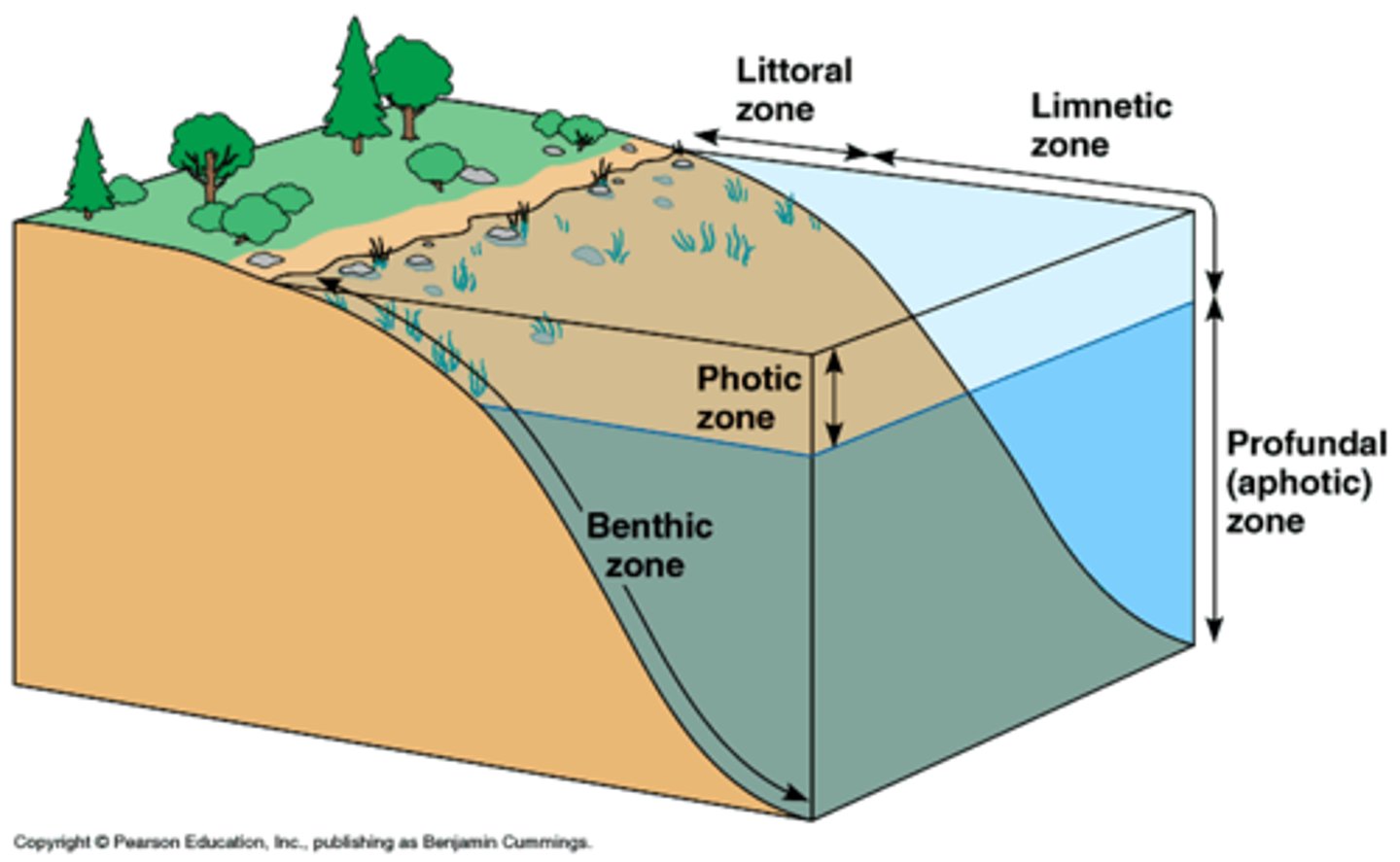
supralittoral zone
"splash" zone; rarely covered with water
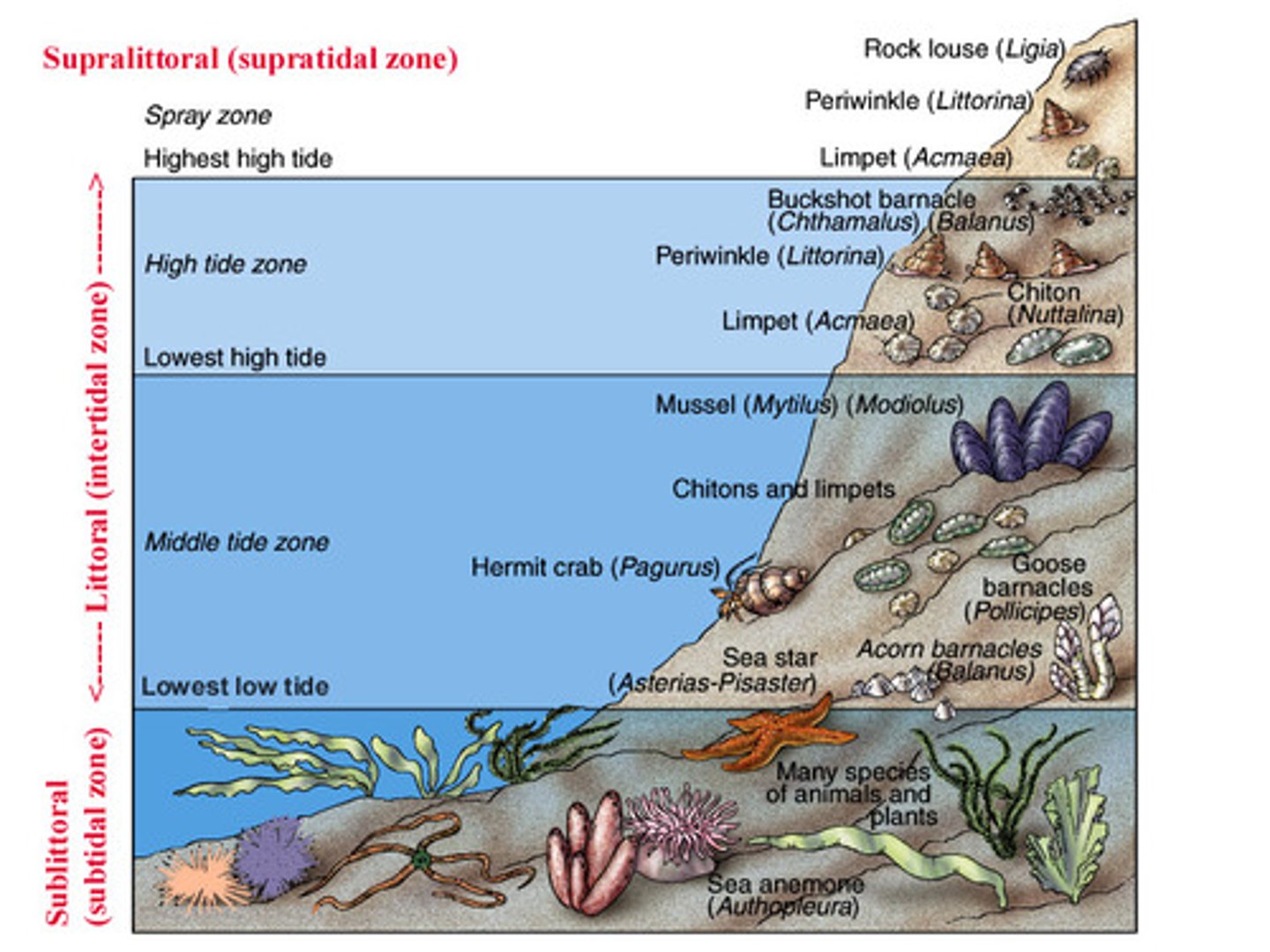
Eulittoral zone
The area between high tide and low tide. Organisms here must be adapted to live in wet and dry environments; intertidal zone
Sublittoral zone
the ocean zone that begins at the low-tide limit and stretches to the edge of the continental shelf; never uncovered with water

Continental shelf
part of a continent that extends out underneath the ocean; avg. depth 150-200 m
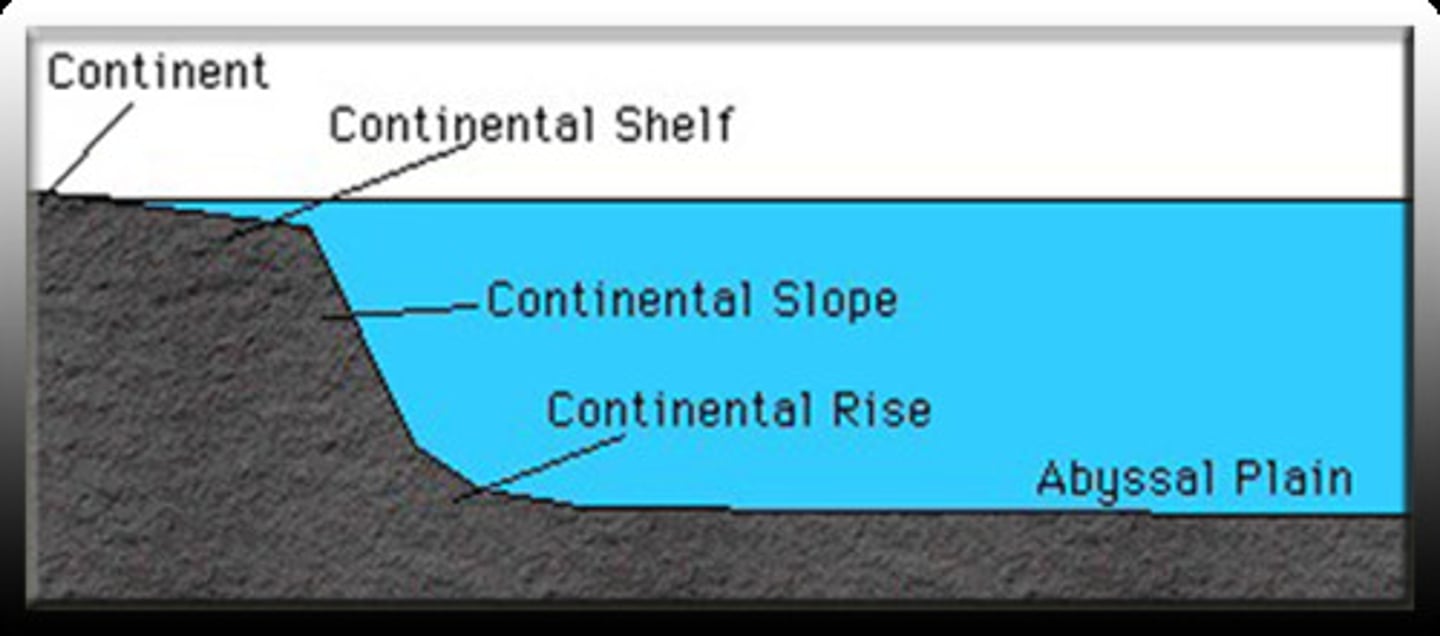
Continental edge
The point at which the continental shelf which surrounds each continent begins to angle sharply downward
Abyssal plain
a large, flat, almost level area of the deep-ocean basin;
contains seamounts, ridges and mountain ranges (avg. 4km below surface)
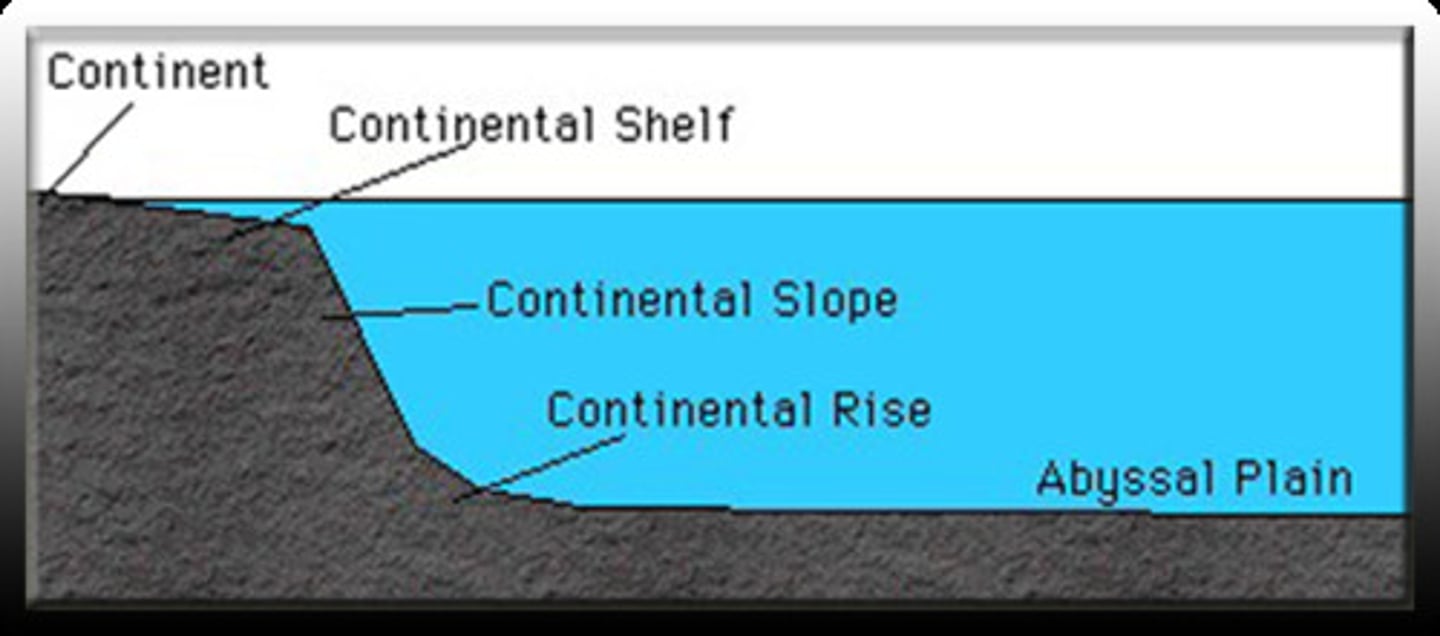
Pelagic
open ocean
Epipelagic zone
The lighted, or photic, zone in the ocean.
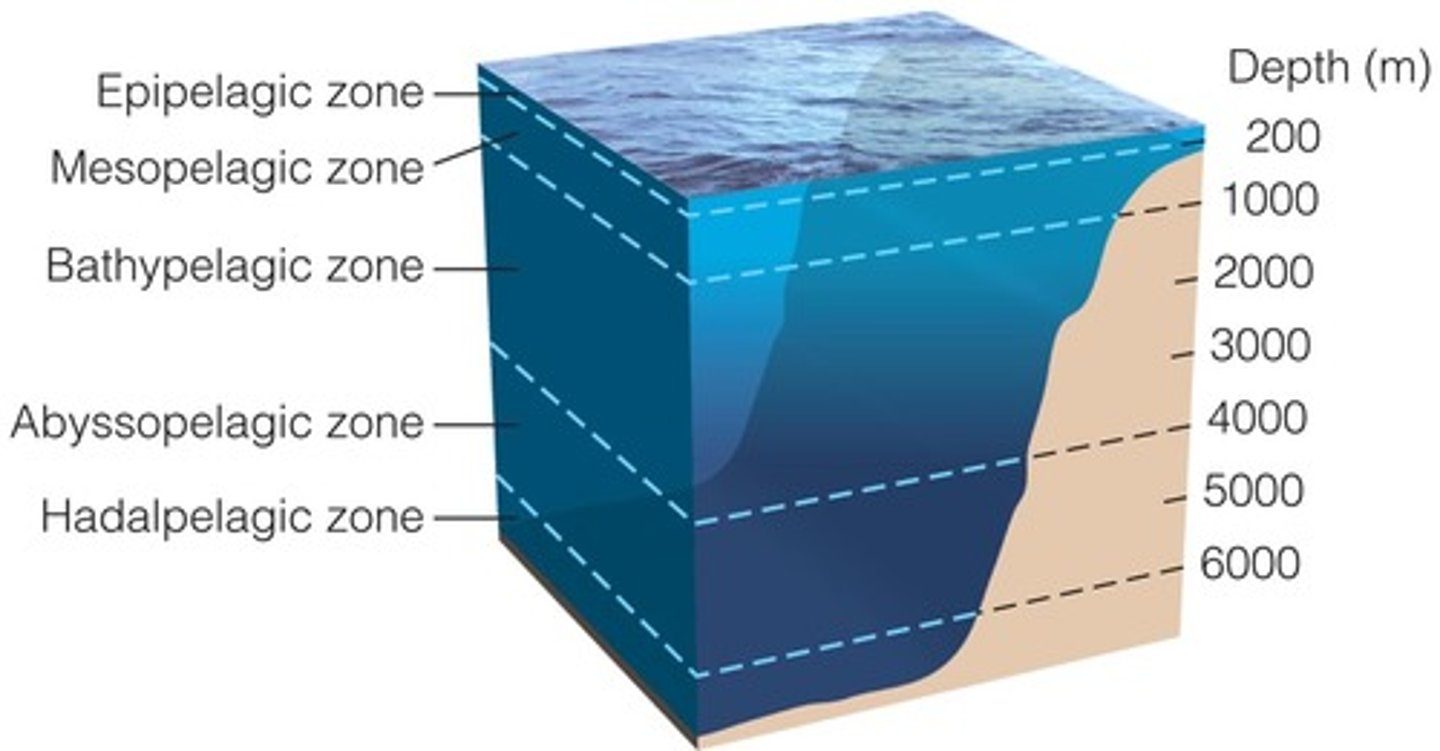
Mesopelagic zone
The pelagic layer of the ocean where light can penetrate, yet without the intensity to support photosynthesis
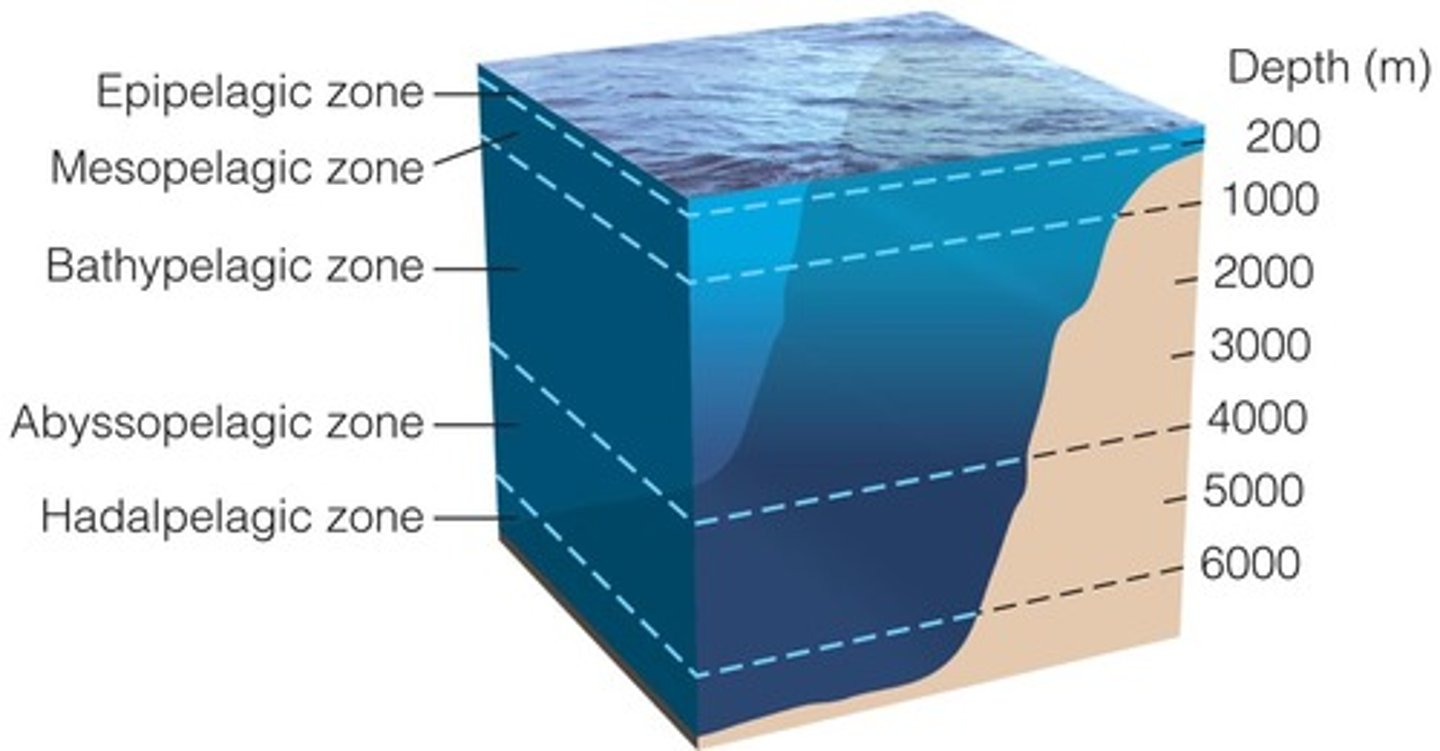
Bathypelagic zone
The pelagic environment from a depth of 1000 m to 4000 m. No sunlight at all.
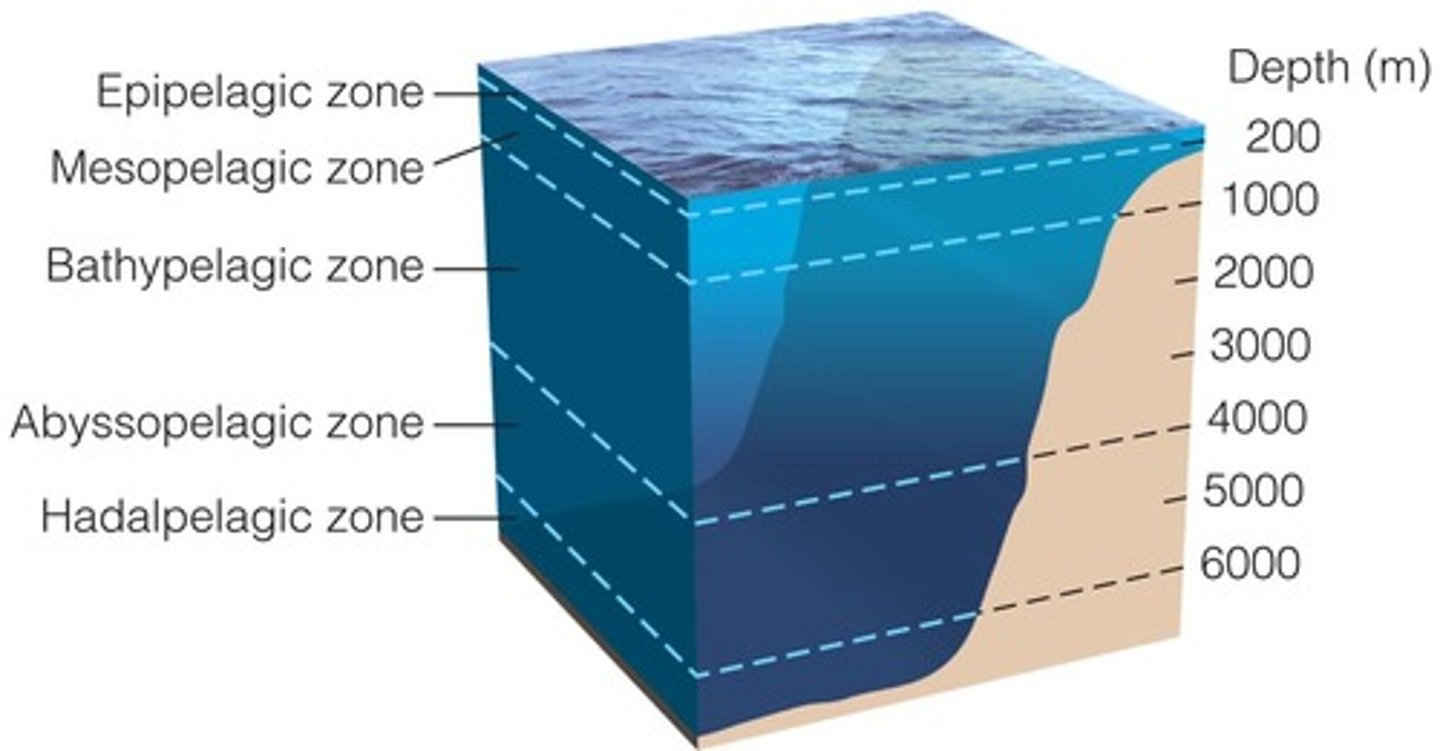
Abyssopelagic zone
The pelagic environment from a depth of approximately 4000m to 6000 m. No sunlight at all.
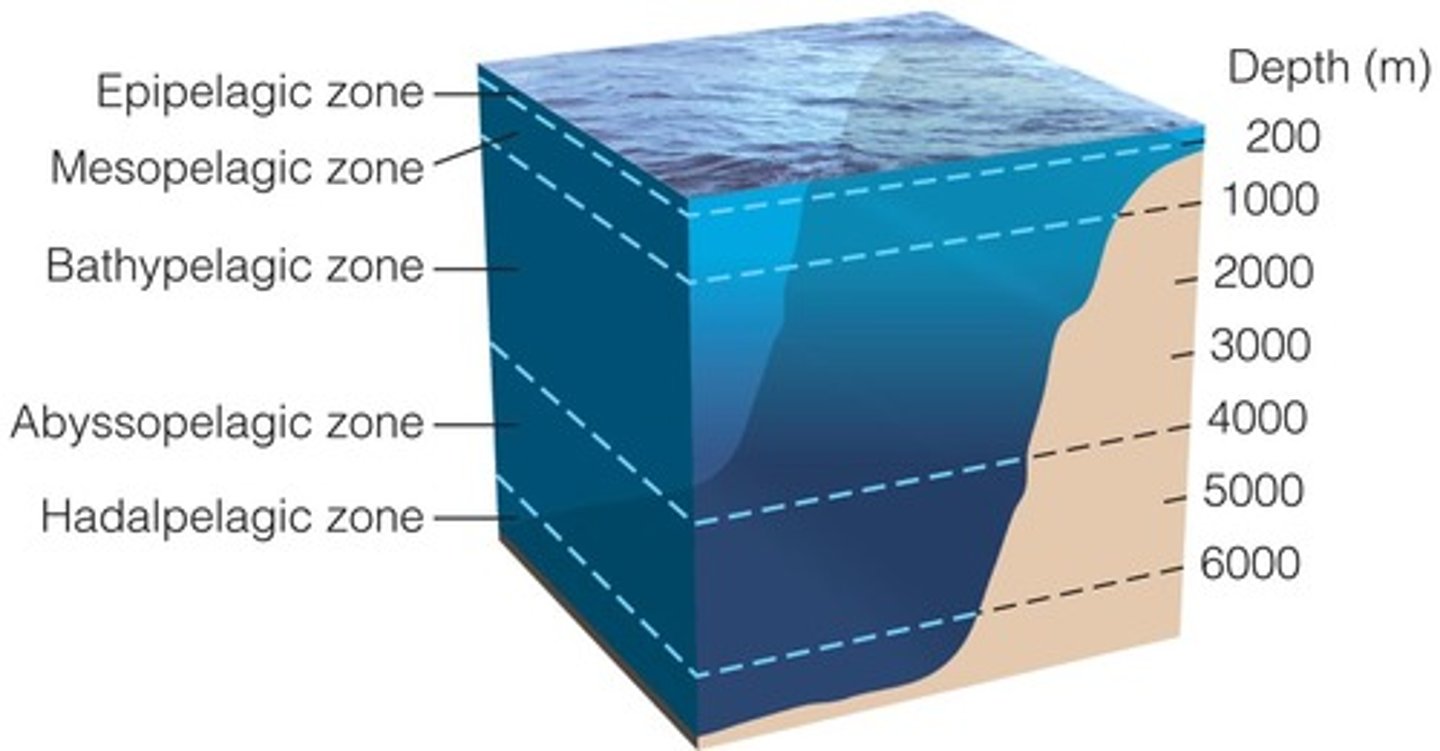
Hadalpelagic zone
includes areas found in deep-sea trenches and canyons (6k meters and deeper)
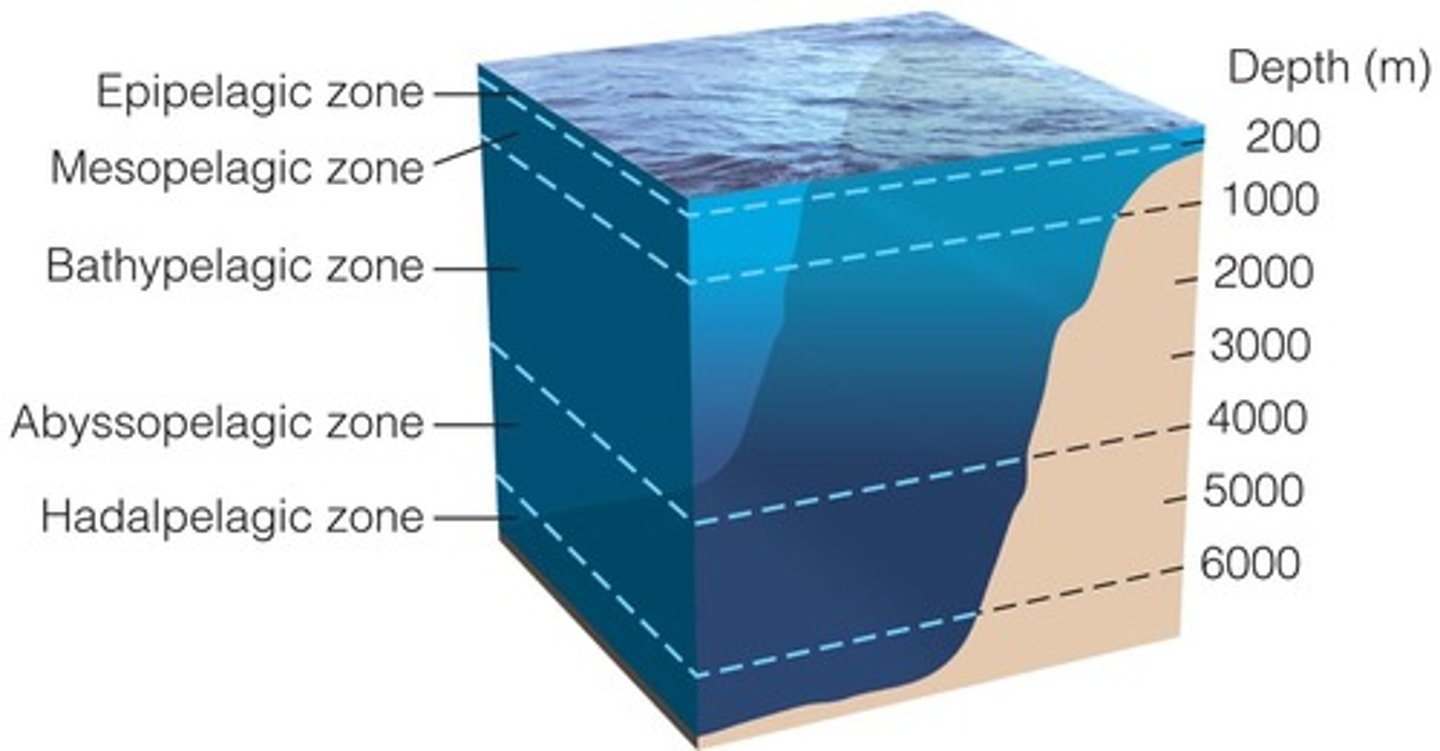
Benthic
bottom of an aquatic ecosystem; consists of sand and sediment and supports its own community of organisms
Demersal
organisms that live near the seafloor
Benthic Boundary Layer (BBL)
the layer of water that sits on top of the bottom of a body of a water; sediment suspension (diversity increases near the bottom of the sea floor)
Epifauna (epibenthic)
Animals that live on the surface of the substrate
ex.
- sea anemones
- sea sponges
- snails
- barnacles
Infauna
animals that burrow in the substrate (large invertebrates)
ex.
- clams
- worms
Interstital organisms
microscopic animals that live in the spaces between sand grains
Meiofauna
organisms smaller than 0.5 mm (fall under interstitial organisms)
Name the five phyla of metazoans that are meiofauna
Gastrotricha
Gnathostomulida
Kinorhyncha
Loricifera
Micrognathozoa
Errant
motile and mobile benthic organisms (crabs and worms)
Sessile
organism that does not move (remains in one place); ex. sponges and corals
Sedentary
organisms weakly attached to their substrate (ex. crinoids, clams, anemones)
Pelagic zone
The open-water component of aquatic biomes.
neritic zone
area of ocean over continental slope
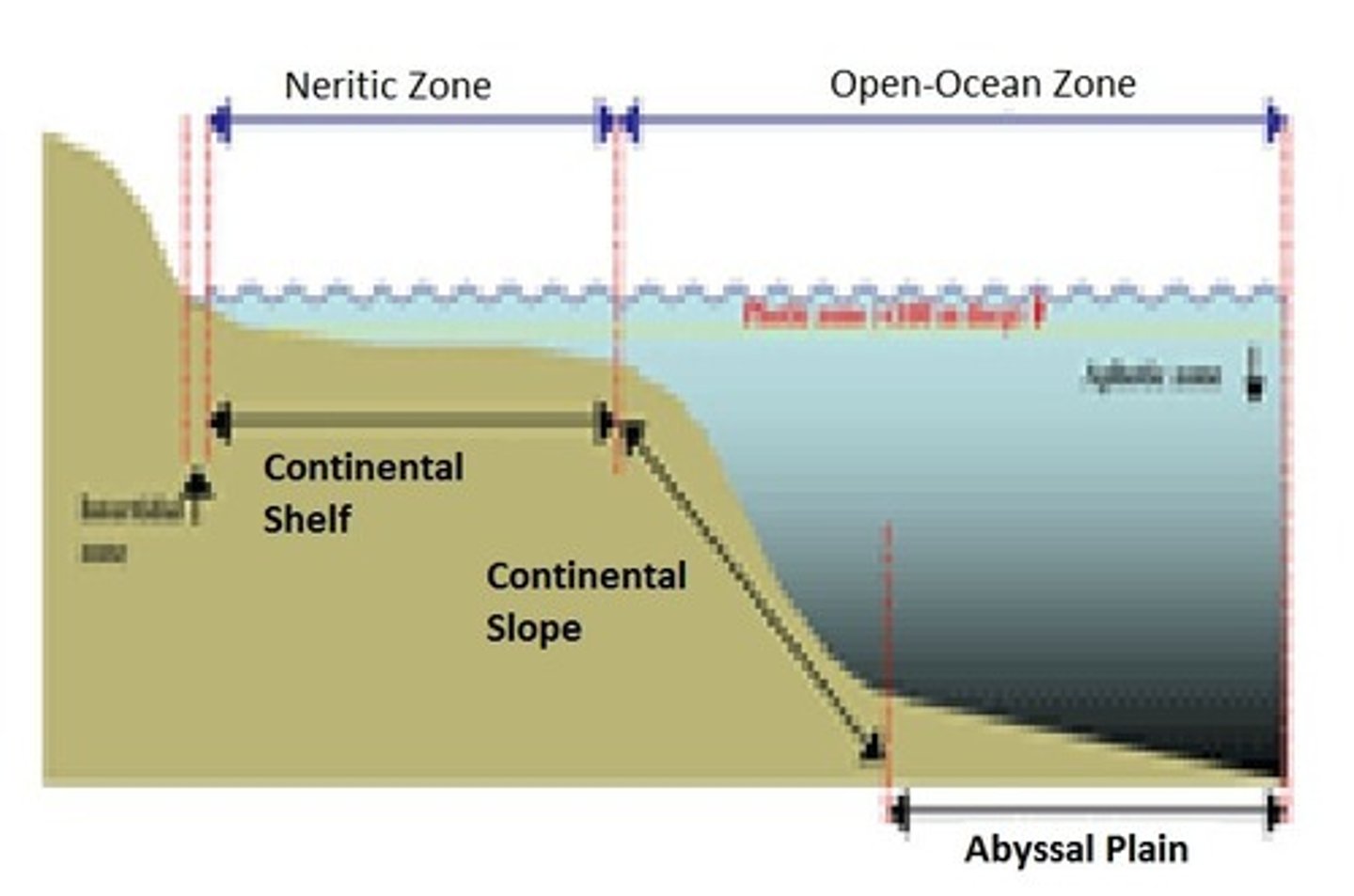
oceanic zone
vast open ocean from the edge of the continental shelf outward
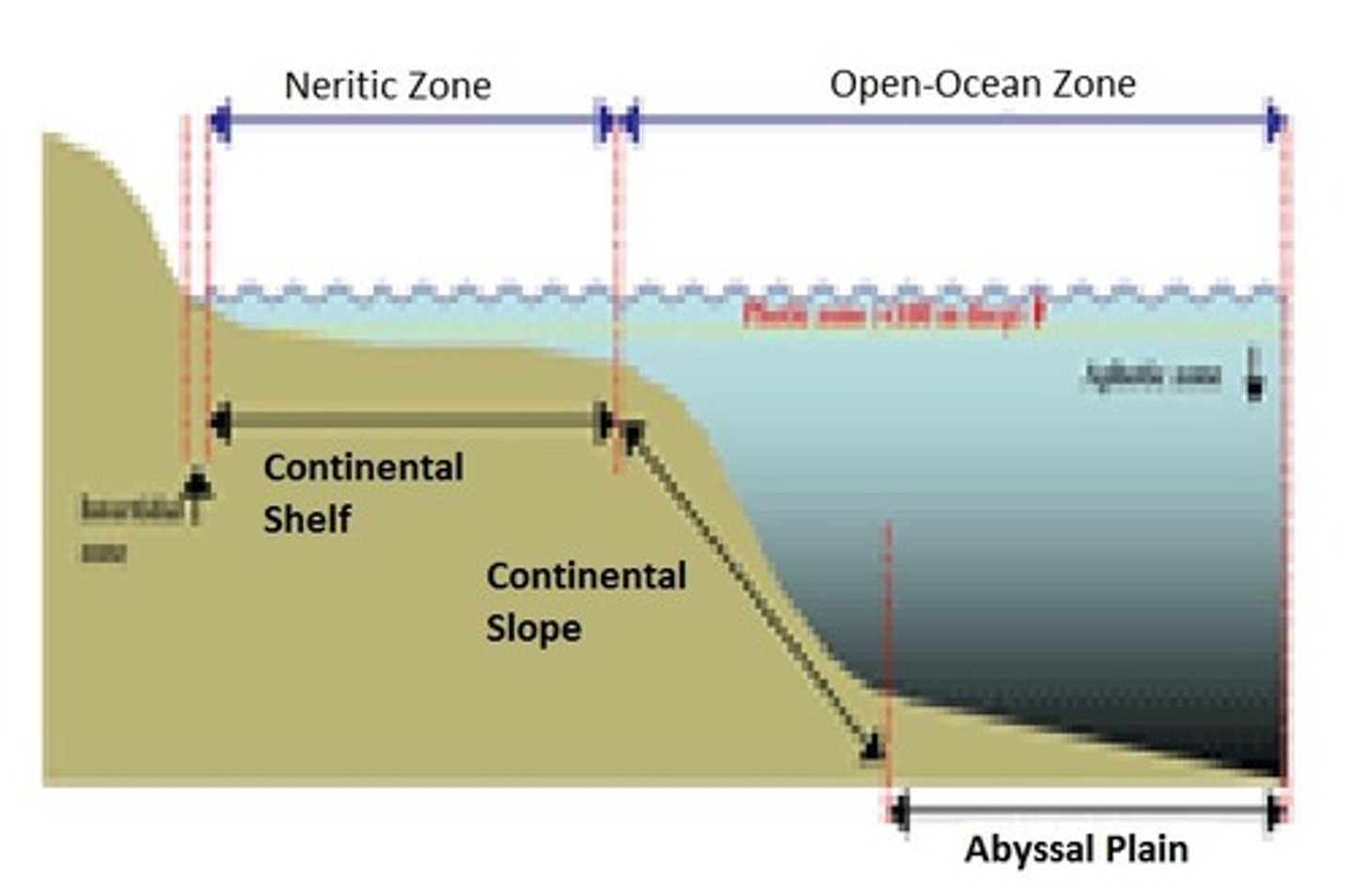
Photic Zone
Portion of the marine biome that is shallow enough for sunlight to penetrate.
Aphotic zone
permanently dark layer of the oceans below the photic zone
consists of:
- disphotic
- twilight
- mesopelagic zone